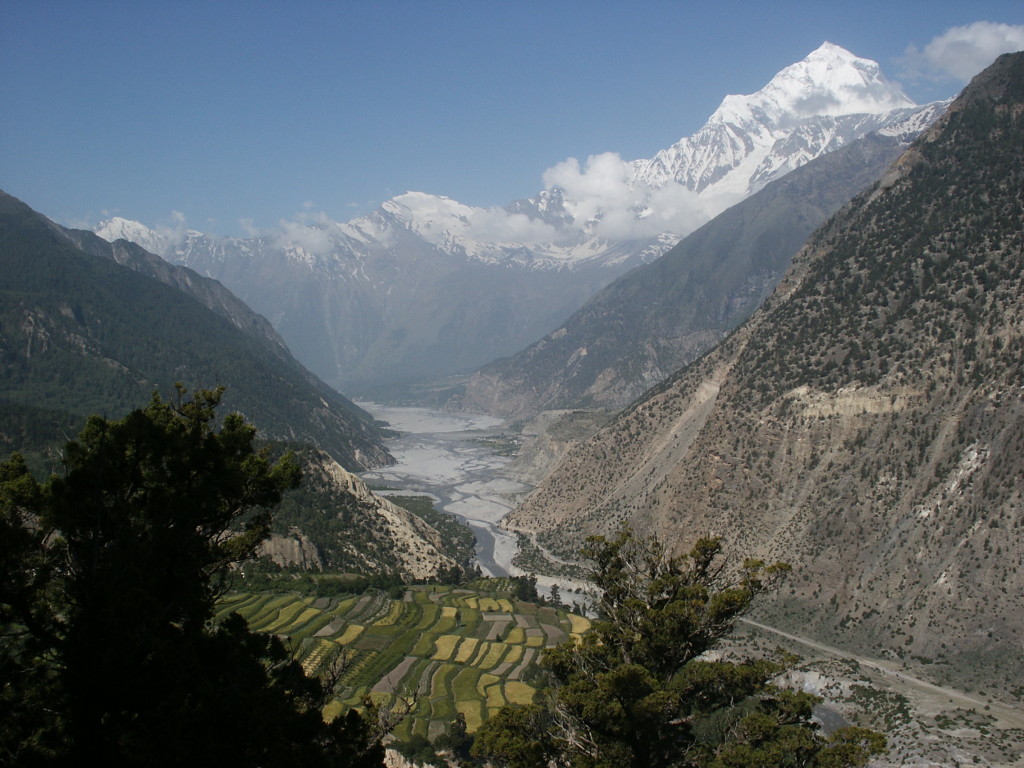June 2, 2004
Lost
The helicopters have been circling for days. At first it was only the small choppers that run tourists from Pokhara to Muktinath weaving in and out of the hills and cliffs. Never too close – the afternoon winds are too unpredictable and a sudden gust could slam one of these light machines into a cliff face or hillside. Bhumi-sir told me over dinner that the are searching for a lost climber. A Slovenian who went missing from his expedition on Dhaulagiri.
The next day one of the huge Russian helicopters appeared, thundering down the valley from Tukuche and ponderously disappearing over the yak kharkas to search the ravines and crevasses below the Dhaulagiri icefall.
 Later, six days after the searching had begun, I walked south with Andrew and Derek. We were headed to Lete to help Beth with her GLOW camp. On the way, we stopped at the High Plains Inn in Tukuche to visit our friends Patrick and Purna who ran the place. When we entered, we stepped into a crowd of Nepalis and badeshis (foreigners). Purna came to us and told of the rescue mission that was happening. Dozens of locals, porters, shepherds, and guides, were all up on the slopes of the mountain searching for the lost climber. He had come from Slovenia as part of an expedition to summit Dhaulagiri, the world’s 6th tallest mountain. Of the 13 who set out, he had been the only one not to reach the peak. He had been hit hard by altitude sickness, showing the drunken, incoherent behavior that spoke of cerebral edema, and had been forced to descend to a lower altitude about halfway down the mountain. On the next day, his climbing partners passed him on the way down. They thought that he had joined them, but at the end of the day, he was not with them.
Later, six days after the searching had begun, I walked south with Andrew and Derek. We were headed to Lete to help Beth with her GLOW camp. On the way, we stopped at the High Plains Inn in Tukuche to visit our friends Patrick and Purna who ran the place. When we entered, we stepped into a crowd of Nepalis and badeshis (foreigners). Purna came to us and told of the rescue mission that was happening. Dozens of locals, porters, shepherds, and guides, were all up on the slopes of the mountain searching for the lost climber. He had come from Slovenia as part of an expedition to summit Dhaulagiri, the world’s 6th tallest mountain. Of the 13 who set out, he had been the only one not to reach the peak. He had been hit hard by altitude sickness, showing the drunken, incoherent behavior that spoke of cerebral edema, and had been forced to descend to a lower altitude about halfway down the mountain. On the next day, his climbing partners passed him on the way down. They thought that he had joined them, but at the end of the day, he was not with them.
Now Purna’s husband, Patrick, was up in the big Russian helicopter. Patrick had spent the last six years climbing the lesser peaks of the area and was intimately familiar with the terrain of Dhaulagiri’s lower reaches. So because of his knowledge and experience, he was guiding the Russian pilot amongst the crags and crevasses. Because of the helicopter’s mass that somewhat offset the blowing winds and the skill of the Russian pilot, they were able to get into places that the smaller helicopters were unable to reach, at times hovering in mountain clefts barely wider than the diameter of the big chopper’s blades.
As we spoke, we heard the building shaking ‘thump-thump’ of the chopper passing low overhead and then setting down in the nearby schoolyard. A few minutes later, Patrick came in with the disappointment of another unsuccessful day. He was now just grabbing a few things and then was headed up to Jomsom where they would set the helicopter down for the night before going out again at daybreak. Patrick asked if we wanted to go along for the ride, but our cursed sense of responsibility overrode our desire to fly in the old Soviet military machine and we continued on our way to help Beth with her girl’s camp in Lete.
Seven days later, word came to me in Chhairo that the Slovenian had been found. Apparently he had gotten disoriented in the clouds above the yak kharkas, and, already unsteady due to his altitude sickness, had fallen into a ravine. There, he died due to exposure. Patrick swore that they had looked in that very place repeatedly, but it was a yak herder who came across the body 13 days after the man had disappeared. The Slovenian had been an extremely wealthy businessman, as was evidenced by the hiring of the Russian chopper, which used more than a thousand dollars a day for gasoline, for five days. His family paid the yak herder $10,000 for finding the body, an amount more than he could expect to see in a lifetime of working in Nepal. Later they flew Patrick and Purna to Slovenia in gratitude for their help.
Once again the mountains impressed upon me their might over the lives of those who live and travel here. Having been here for over 16 months, I have come to understand a profound respect for the land and just how much it can mess you up. Snowblindness and minor altitude sickness were some of the lesser hazards that I experienced. Having grown up in Michigan, I was used to forests and rivers and streams that were relatively benign. If you got lost in the woods, you just walked until you inevitably hit a logging road or country highway. Get lost in the Himalayas and more likely than not, you’ll end up like the unfortunate Slovenian businessman. This place is not to be taken lightly.